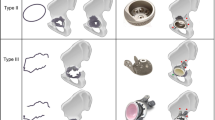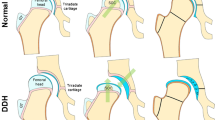Abstract
Purpose
Pelvic tilt determines functional orientation of the acetabulum. In this study, we investigated the interaction of pelvic tilt and functional acetabular anteversion (AA) in supine position.
Methods
Pelvic tilt and AA of 138 individuals were measured by computed tomography (CT). AA was calculated in relation to the anterior pelvic plane (APP) and relative to the table plane. We analysed these parameters for gender-specific and age-related differences.
Results
The mean pelvic tilt was -0.1 ± 5.5°. Pelvic sagittal rotation displayed no gender nor age related differences. Females showed higher angles of AA compared with males (20.0° vs 17.2°, p < 0.001; AA relative to the APP). Anterior tilting of the pelvis positively correlated with AA and individuals with high AA had a higher anterior pelvic tilt compared with those with low AA (p < 0.0001; AA relative to the APP).
Conclusions
AA has to be calculated regarding pelvic sagittal rotation for correct acetabular orientation. Pelvic tilt is dependent on acetabular orientation and compensates for increased AA.



Similar content being viewed by others
References
Wassilew GI, Janz V, Heller MO, Tohtz S, Rogalla P, Hein P, Perka C (2013) Real time visualization of femoroacetabular impingement and subluxation using 320-slice computed tomography. J Orthop Res 31(2):275–281
Merle C, Grammatopoulos G, Waldstein W, Pegg E, Pandit H, Aldinger PR, Gill HS, Murray DW (2013) Comparison of native anatomy with recommended safe component orientation in total hip arthroplasty for primary osteoarthritis. J Bone Joint Surg Am 95(22):e172
Pullen WM, Henebry A, Gaskill T (2014) Variability of acetabular coverage between supine and weightbearing pelvic radiographs. Am J Sports Med 42(11):2643–2648
Fujii M, Nakashima Y, Sato T, Akiyama M, Iwamoto Y (2012) Acetabular tilt correlates with acetabular version and coverage in hip dysplasia. Clin Orthop Relat Res 470(10):2827–2835
Parratte S, Pagnano MW, Coleman-Wood K, Kaufman KR, Berry DJ (2009) The 2008 Frank Stinchfield award: variation in postoperative pelvic tilt may confound the accuracy of hip navigation systems. Clin Orthop Relat Res 467(1):43–49
Lazennec JY, Boyer P, Gorin M, Catonne Y, Rousseau MA (2010) Acetabular anteversion with CT in supine, simulated standing, and sitting positions in a THA patient population. Clin Orthop Relat Res 469(4):1103–1109
van Bosse HJ, Lee D, Henderson ER, Sala DA, Feldman DS (2011) Pelvic positioning creates error in CT acetabular measurements. Clin Orthop Relat Res 469(6):1683–1691
Lazennec JY, Charlot N, Gorin M, Roger B, Arafati N, Bissery A, Saillant G (2004) Hip-spine relationship: a radio-anatomical study for optimization in acetabular cup positioning. Surg Radiol Anat 26(2):136–144
Le Huec JC, Aunoble S, Philippe L, Nicolas P (2011) Pelvic parameters: origin and significance. Eur Spine J 20(Suppl 5):564–571
Legaye J (2009) Influence of the sagittal balance of the spine on the anterior pelvic plane and on the acetabular orientation. Int Orthop 33(6):1695–1700
Au J, Perriman DM, Neeman TM, Smith PN (2014) Standing or supine x-rays after total hip replacement—when is the safe zone not safe? Hip Int 24(6):616–623
Grammatopoulos G, Pandit HG, da Assuncao R, Taylor A, McLardy-Smith P, De Smet KA, Murray DW, Gill HS (2014) Pelvic position and movement during hip replacement. Bone Joint J 96-B(7):876–883
Tannast M, Fritsch S, Zheng G, Siebenrock KA, Steppacher SD (2015) Which radiographic hip parameters do not have to be corrected for pelvic rotation and tilt? Clin Orthop Relat Res 473(4):1255–1266
Wassilew GI, Heller MO, Diederichs G, Janz V, Wenzl M, Perka C (2012) Standardized AP radiographs do not provide reliable diagnostic measures for the assessment of acetabular retroversion. J Orthop Res 30(9):1369–1376
Tohtz SW, Sassy D, Matziolis G, Preininger B, Perka C, Hasart O (2010) CT evaluation of native acetabular orientation and localization: sex-specific data comparison on 336 hip joints. Technol Health Care 18(2):129–136
Wassilew GI, Janz V, Heller M, Wenzl M, Perka C, Hasart O (2011) Validation of a CT image based software for three-dimensional measurement of acetabular cup orientation. Technol Health Care 19(3):185–193
Wohlrab D, Radetzki F, Noser H (2012) Mendel T Cup positioning in total hip arthoplasty: spatial alignment of the acetabular entry plane. Arch Orthop Trauma Surg 132(1):1–7
Eilander W, Harris SJ, Henkus HE, Cobb JP, Hogervorst T (2013) Functional acetabular component position with supine total hip replacement. Bone Joint J 95-B:1326–1331
Matsuyama Y, Hasegawa Y, Yoshihara H, Tsuji T, Sakai Y, Nakamura H, Kawakami N, Kanemura T, Yukawa Y, Ishiguro N (2004) Hip-spine syndrome: total sagittal alignment of the spine and clinical symptoms in patients with bilateral congenital hip dislocation. Spine (Phila Pa 1976) 29(21):2432–2437
Preininger B, Haschke F, Perka C (2014) Diagnostics and therapy of luxation after total hip arthroplasty. Orthopade 43(1):54–63
Stephens A, Munir S, Shah S, Walter WL (2015) The kinematic relationship between sitting and standing posture and pelvic inclination and its significance to cup positioning in total hip arthroplasty. Int Orthop 39(3):383–388
Dandachli W, Ul Islam S, Richards R, Hall-Craggs M, Witt J (2013) The influence of pelvic tilt on acetabular orientation and cover: a three-dimensional computerised tomography analysis. Hip Int 23(1):87–92
Murphy WS, Klingenstein G, Murphy SB, Zheng G (2013) Pelvic tilt is minimally changed by total hip arthroplasty. Clin Orthop Relat Res 471(2):417–421
Journé A, Sadaka J, Belicourt C, Sautet A (2012) New method for measuring acetabular component positioning with EOS imaging: feasibility study on dry bone. Int Orthop 36(11):2205–2209
Babisch JW, Layher F, Amiot LP (2008) The rationale for tilt-adjusted acetabular cup navigation. J Bone Joint Surg Am 90(2):357–365
Lubovsky O, Peleg E, Joskowicz L, Liebergall M, Khoury A (2010) Acetabular orientation variability and symmetry based on CT scans of adults. Int J Comput Assist Radiol Surg 5(5):449–454
Conflict of interest
None.
Author information
Authors and Affiliations
Corresponding author
Rights and permissions
About this article
Cite this article
Zahn, R.K., Grotjohann, S., Ramm, H. et al. Pelvic tilt compensates for increased acetabular anteversion. International Orthopaedics (SICOT) 40, 1571–1575 (2016). https://doi.org/10.1007/s00264-015-2949-6
Received:
Accepted:
Published:
Issue Date:
DOI: https://doi.org/10.1007/s00264-015-2949-6




